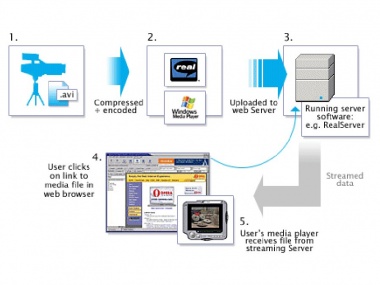Streaming Media Technology
From Computing and Software Wiki
(→References) |
(→Introduction) |
||
| Line 4: | Line 4: | ||
== Introduction == | == Introduction == | ||
| - | + | When the user requests to display a media object, which is stored on a remote server, the data blocks are retrieved from the remote server over a network | |
== System Architecture == | == System Architecture == | ||
Revision as of 00:22, 9 April 2008
Streaming media is multimedia that is constantly received by, and normally displayed to, the end-user while it is being delivered by the provider.[1] Streaming media technolgy enables on-demand or real-time access to multimedia content via internet and allows users to play those contents without fully downloading them. After playing, there's no copy of played contents leaving on the receiving devices, which protects the copyright of the original mutimedia contents.
Contents |
Introduction
When the user requests to display a media object, which is stored on a remote server, the data blocks are retrieved from the remote server over a network
System Architecture
To be filled
Storage and Bandwidth
To be filled
Data Compression
Run-length encoding
Relative encoding
Huffman encoding
Transform encoding
To be filled
Network Protocols
RTP
RTCP
RTSP
RSVP
To be filled
Applications
- A
- B
- C
- D
References
[1] Wikipedia, "Streaming Media", April 2008, "http://en.wikipedia.org/wiki/Streaming_media" .
[2] Sequence website, "http://www.sequence.co.uk/services/streamingmedia/howdoesitwork.html" .
See also
External links
- streamingmedia.com - Streaming Media Industry News
- Streaming Media - Streaming Media Wiki Page
- TCP/IP_model - Protocols on the Five-layer TCP/IP Model
--Chuh 15:58, 7 April 2008 (EDT)

